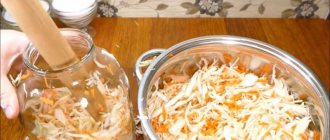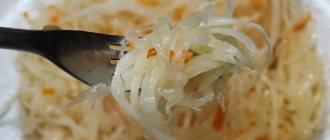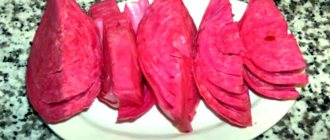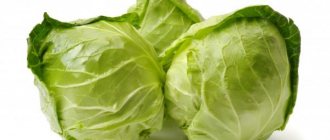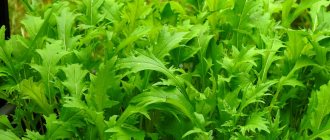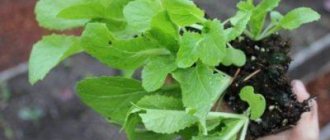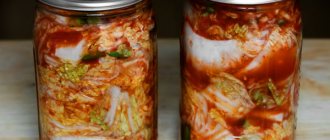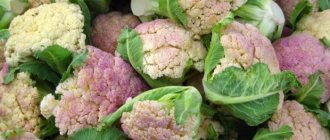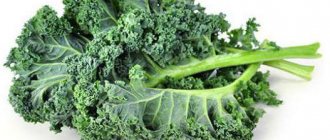The benefits of sauerkraut
Sauerkraut is a real healer for many diseases due to its high content of various vitamins. Surprisingly, sauerkraut has long been used even in folk medicine. Not only the vegetable itself, but also its brine has special properties.
Useful properties of sauerkraut:
- Vitamin “bomb” . The leading component is Vitamin C. Its role in strengthening the immune system and maintaining the strength of our body has long been known to everyone. In addition, pickled vegetables contain vitamins A, B, K and PP, as well as essential microelements such as calcium, iron, zinc, selenium, phosphorus and, of course, iodine.
- Healing acid . In addition to increasing the level of immunity, sauerkraut has a major effect on the stomach. The acid contained in the brine prevents diseases of the gastrointestinal tract, gastritis, indigestion and has a beneficial effect on digestion. It is believed that consuming this product half an hour before each meal reduces the risk of stomach disease and improves its microflora.
Activation of the action of vitamins occurs due to oxidation , which is why pickled cabbage is healthier than raw cabbage. Also, after fermentation, fiber is destroyed, which contributes to better absorption of the product by the body.
Nutritionists say that this product is able to reduce blood sugar and cholesterol levels , which explains its popularity among people with diabetes. Possessing unique properties and low calorie content, sauerkraut has won the love of even the most fastidious gourmets.
Why does sauerkraut turn dark?
Despite the fact that the process of making sauerkraut is simple and does not require special skills from the housewife, the chemical process itself that occurs inside the vegetable is complex and sensitive to violations of technology . One of the deviations as a result of improper preparation is darkening of the product.
If the cabbage has turned gray, this negatively affects, firstly, the presentation of the food, and in some cases it can affect the taste of the product or even destroy the product. Darkening can occur for several reasons, which we will discuss below.
There are several reasons why cabbage darkened when salted.:
- incorrect quantity and quality of salt;
- variety unsuitable for pickling;
- non-compliance with temperature conditions and fermentation time;
- salting without oppression;
- oak containers;
- oxygen access;
- active development of dangerous microorganisms.
Incorrect amount of salt
Pickling is the preparation of vegetables using lactic acid fermentation . For this, only the white parts of the vegetable are used, not too ground. It is thanks to lactic acid that the vegetable is preserved and becomes sour.
Reference! This chemical process is impossible without the participation of salt. Salt neutralizes bad bacteria and enhances the preservative effect of lactic acid.
It is thanks to salt that sauerkraut can be stored and not spoil, so in this chemical reaction it is one of the key elements . The salt should be table salt, coarsely ground (in no case fine) and without impurities.
Important! A lack of salt leads to a slowdown in the fermentation process, and an excess leads to the neutralization of beneficial bacteria. Experienced housewives recommend using 20-24 g of salt per 1 kg of vegetables.
Iodized salt
The use of iodized and Himalayan salt with additives changes the chemical processes that occur during fermentation. As a result, a change in the color and taste of the snack.
Cabbage variety
Choosing the right variety is the key to successful fermentation. The color of the snack will change if the hostess chose a low-quality vegetable for preparation . Preference is given to sweetish mid-late or late varieties: Nadezhda, Podarok, Slava.
For pickling, well-ripened, not frozen, dense heads of cabbage are used . It is important that there are no voids inside. The leaf color should be white or slightly yellowish.
Important! Frozen, heavily damaged and contaminated heads of cabbage are not suitable for pickling.
Failure to comply with fermentation temperature and time
After pickling, the fermentation process is divided into three stages , each of which involves different chemical processes requiring individual environmental conditions:
First stage
Active reproduction of lactic acid bacteria . Table salt added during the harvesting process causes plasmolysis of vegetable cells and provokes the evaporation of moisture from the secreted juice. Thanks to plasmolysis, the active substances pass into the brine. As the moisture evaporates, the salt will evaporate.
From this stage, the development of lactic acid and other bacteria begins , among which the former eventually occupy a predominant position. The brine is characterized by turbidity and increased gas formation. The duration of this stage depends on the temperature.
The most favorable conditions for the process to proceed correctly is a temperature of +17. +24°C, at which 2–3 days are enough to move to the next stage. Low thermal indicators will cause a slowdown in fermentation, which will disrupt all further technology, and high ones will affect the formation of bad microflora.
Second phase
Characterized by the release of lactic acid . The best condition for the fermentation process will be a temperature within +20°C for 5–7 days. This is due to the proliferation of lactic bacteria and inhibition of negative reactions.
If everything is maintained correctly at this stage, the vegetable will concentrate the maximum amount of vitamin C.
This is interesting: Tips for housewives: when can you salt cabbage in November 2020
Third stage
This is post-fermentation, which should take place at a temperature no higher than 0°C and no lower than –2°C . An increase in temperature will provoke the development of mold, which will completely spoil the product and make it unfit for consumption. Fermentation time takes several months.
Fermentation time
Each stage differs not only in the chemical processes that occur, but also in the fermentation time.
If you adhere to the recommended temperature, then:
- the first stage will take 2-3 days;
- the second will last 5-7 days;
- the third - several months.
No oppression
Oppression is used to compact ingredients and block oxygen access . The top layer of the workpiece turns black due to the weathering of the liquid and the entry of air. What should be the weight of an object used as a weighting agent?
This is interesting! Previously, in Rus', housewives used ordinary scalded cobblestones, the weight of which was equal to 1/10 of the mass of cabbage.
Now many people ferment vegetables in glass jars. Water poured into a plastic bottle or a smaller jar is used as oppression .
Ignoring gas relief
Beginning housewives are perplexed as to why they need to pierce the cabbage during fermentation. During fermentation, a large volume of gases is released, which begins to displace the brine. If you do not release gases from the jar, the color deteriorates and the taste begins to taste bitter .
The cabbage is pierced with a wooden stick for 2-3 days - as soon as foam appears on the surface of the container. The procedure is carried out 1-2 times a day. Make sure the stick reaches the bottom of the container.
Why does it change color
When pickled, cabbage looks beautiful when it is white, but simple salt can ruin its aesthetic appearance. Yes, it turns out that for cooking you should use coarse rock salt, without any additives - I checked this from my own experience. Also, you can’t overdo it or underuse this product. Because then the growth of lactic acid bacteria will clearly be reduced, and this will lead to a darkening of the color.
Important!
When cooking, it is necessary to distribute the salt evenly!
We must not forget about the brine, which should cover the product and prevent it from interacting with oxygen. If the brine leaks out or evaporates, the cabbage almost immediately changes color. The container plays an equally important role during cooking. Darkening of the product may occur due to the interaction of the salt solution, for example, with metal utensils.
Cabbage also darkens when:
- rotting;
- mold formation;
- violation of the technological process of preparation;
- the product is poorly washed;
- ingestion of yeast fungi;
- storage in a warm room;
- entry of bacteria;
- prescription violation.
Important!
For pickling, it is better to choose late varieties of cabbage with light leaves!
With beets, cabbage turns out a beautiful lilac color, try this quick recipe.
Is it possible to eat darkened cabbage?
Many housewives wonder whether it is possible to eat darkened sauerkraut, because you really don’t want to throw away this healthy product. If a vegetable has darkened due to physical processes rather than biological ones, then it must be consumed .
To do this, you will need to overcome your dislike for her unattractive appearance :
- The top layer of the vegetable has darkened due to the weathering of the brine . During the fermentation process, moisture evaporates, and the part of the cabbage that is left without juice turns black due to the oxidation of oxygen. It is enough to remove the top layer, and the rest of the cabbage can be eaten.
- The workpiece has darkened due to carrots . A large amount of carrots (especially grated ones) colors the product. Although this cabbage has lost its appetizing appearance, it is quite ready for use.
- The product has darkened due to the use of iodized salt . Any salt with impurities gives rise to other chemical processes, which spoil the taste of the product and also deprive the vegetable of its whiteness.
- The sauerkraut has darkened due to a chemical reaction with the material of the container in which it is stored.
- The cabbage became slimy . It should be rightly noted that, in addition to the darkening defect, a defect such as the formation of mucus may also occur. If this mucus is transparent, then this is the result of too active proliferation of lactic bacteria. This preparation is suitable for use, but has an extremely unattractive appearance.
Biological causes of browning that affect the edibility of the product :
- Development of pathological microflora . In this case, darkening occurs as a result of the activity of third-party bacteria. The reason could be an increase in storage temperature during fermentation. This workpiece is not suitable for use.
- Mold formation . Even if mold has formed on the surface of the workpiece, it affects the entire product and should absolutely not be consumed.
- Darkening in the form of red cabbage . The redness of the vegetable is caused by the activity of fungi. The reason could be increased fermentation temperature and insufficient salt.
- The appearance of rot . Rotting is caused by mold fungi. Any rot is pathogenic, so this product should not be eaten.
What to do with browned cabbage
If the reason for the darkening of the product is due to physical processes , it can be consumed. But if the cabbage has changed its color for biological reasons, it is disposed of.
Important! A color change to red indicates fungal activity. This product cannot be eaten. Extinguishing the situation will not save the situation.
Severely darkened sauerkraut cannot be stored . If it begins to turn black due to mold, it is not enough to remove the fungus on top - it has already affected the entire workpiece. It's better to throw it away.
How to avoid loss of presentation
To get high-quality and tasty sauerkraut, you need to ensure compliance with the manufacturing technology, as well as comply with sanitary standards. For cooking, use only high-quality forks of late or mid-late varieties. There are many varieties of late cabbage that retain their presentation for a long time. Early varieties have loose heads, and the sauerkraut will not be of the best quality; one might even say that it will be a second-rate product. Use only coarse salt for pickling and without any foreign impurities. Choose the right container for pickling and storage.
Recommendations for sauerkraut
Even such a simple process as fermentation has many nuances, without which you will not get a high-quality product. It all starts with choosing a vegetable. As a rule, white cabbage is used for fermentation, since it is able to retain ascorbic acid after fermentation and has good taste.
The vegetable must be mature - “in its very juice”, with dense and thin leaves . The top leaves must be removed, as they can also cause darkening of the future product. For pickling, only light heads of sweet varieties are taken and only light leaves are cut.
If you decide to add carrots for taste, it is better to chop them rather than grate them . Since grinding too finely will cause a large amount of juice, which will color the cabbage and change its taste.
There are also recipes with the addition of grapes and apples , but the most popular additions remain carrots and cranberries. To ensure that pickled cabbage remains snow-white, some housewives marinate it separately, and then mix it with cabbage once the preparations are ready. To keep the vegetable crispy, watch the brine level, it affects not only the color, but also the structure. When the juice level decreases, just add salted water.
To add a piquant taste to fermented vegetables, it is recommended to add sugar . Standard proportions have the following scheme: for 1 liter of water - 1 tablespoon of sugar, 1.5 tablespoons of salt. During the first periods of fermentation, it is necessary to release gas (to do this, the cabbage is “pierced” with a sterile wooden stick in several places).
Since acids are released during fermentation, choosing the right container is very important to prevent oxidation of metals and spoilage of the product. Glass, enamel and wooden containers are suitable for fermenting vegetables (it should be noted that in a wooden container the workpiece can also take on a gray tint, which is a consequence of natural chemical reactions).
This is interesting: Sauerkraut for the winter: a very tasty snack for any table
What to pay attention to when preparing:
- evenly shredded strips (without stalks and leaves);
- additives (carrots, apples, etc.) are distributed evenly in the cabbage;
- juicy and crispy taste, dense or moderately dense consistency;
- characteristic smell of cabbage, with spicy and fresh notes, absence of foreign odors;
- sweet and sour taste of cabbage, without bitterness;
- spicy brine;
- the color of the workpiece is from white to light yellow.
Proven recipes for preparing delicious snacks
Each housewife has her own, albeit small, secret of delicious pickling cabbage. Some people sauerkraut with apples, some with grapes, but most limit themselves to adding carrots .
The following relationships can be proposed:
- for 10 kg of shredded cabbage 350 g of carrots and 180-200 g of salt;
- for 10 kg of prepared cabbage, 1 kg of apples (preferably Antonovka), cut into halves, and 180-200 g of salt;
- for 10 kg of shredded cabbage 350 g of cranberries, 180-200 g of salt.
Let's look at several recipes for sauerkraut, crispy and white.
Recipes in brine
To begin with, we will describe 3 proven methods for preparing cabbage with brine :
- Chop the cabbage directly into a large container, add carrots to taste and pour brine over a bucket of cold water for 15 minutes - 2 cups of coarse salt. After 15 minutes, take the cabbage with your hands and, as far as you are strong enough, squeeze and tightly fill a 3-liter jar. Then leave it in the kitchen for 3-5 days, periodically piercing it to allow gases to escape and skim off the foam. Then put it in a cool place to infuse. The cabbage turns out white and very crispy.
- Chop the cabbage and mix it with grated carrots . Fill 3-liter jars tightly, not reaching the top by 4 fingers. Sprinkle 2 tablespoons of coarse salt on top. Fill with tap water. Close with a nylon lid and immediately lower it into the basement. The cabbage turns out crispy and almost like fresh, very tasty.
- For 3 kg of cabbage, take 1 tbsp. l. sugar, 1.5 tbsp. l. salt, 1 liter of boiled water . Chop the cabbage and pour in the prepared brine. Keep for 3 days at room temperature, piercing to the bottom with a stick, then put in the cold. The container should be opaque, for example, an enamel pan or bucket. The cabbage should be kept in brine to maintain its white color and crisp texture. Carrots are added as desired.
With pickles
Chop 1 kg of cabbage and add 20–25 g of dill seeds . Grate 500–600 g of pickled cucumbers on a coarse grater.
Mix everything and pour hot brine : 1.5 tbsp. l. salt per 1 liter of water. Place under pressure for 12 hours, then divide into jars and store in the refrigerator.
With pumpkin and herbs
Peel 1 kg of pumpkin from skin and seeds, cut into large slices , add 3 tbsp. l. sugar and leave until the juice releases. Chop 4 kg of cabbage, mix with a bunch of chopped herbs and 130 g of salt.
Place cabbage and pumpkin pieces in layers in the prepared container . Leave at room temperature for several days.
When to ferment
It is known that cabbage has been fermented in Rus' since time immemorial. And our grandmothers managed to preserve the prepared vegetable until spring. Perhaps it has to do with certain rules that we should listen to? And ancient recipes and folk superstitions for pickling delicious cabbage say that you need to add salt :
- on the new moon, before the first quarter, preferably on the 6-7th day of the new moon;
- on Tuesday or Thursday;
- not on the “red days of the calendar”.
Why do pickles turn out soft?
The softening of pickled cucumbers is caused by many bacteria, yeasts , and molds , which form a white film on the surface of the brine. Cucumbers become flabby, their skin is easily rubbed with your fingers. Subsequently, the fruits completely decompose, releasing hydrogen sulfide. The reasons contributing to the development of mold may be poor washing of fruits, containers and equipment . Increased concentrations of salt and lactic acid retard the development of mold, but the taste of cucumbers deteriorates.
The most effective means of preventing it are to isolate products from contact with air, periodically inspect stored cucumbers, and remove mold from the surface of the brine. You can use preservatives: sorbic acid, mustard powder or oil, leaves of grapes, currants, oak, horseradish, dill, etc.
Another reason causing softening is the increased activity of pectolytic enzymes , which are found in cucumber flowers, especially in the ovary, and on the cucumbers themselves. Under conditions of lactic acid fermentation, they retain their activity for a long time, so when preparing for processing, cucumbers need to be washed very well, changing the water. Then rinse in running water to remove any remaining flowers.
| Categories: | Housewife's encyclopedia of cooking: links, sites, prig/Kitchen secrets of cooking |
kitchen secrets, cooking, preparations,
Cited 15 times Liked by: 11 users
Read also: YouTube weaving from willow twigs
And here is my recipe. Guaranteed that the cabbage will be very tasty and crispy
It needs to be fermented no earlier than October, when white cabbage ripens. You need to choose the largest and firmest cabbage. Chop, grate one large carrot on a coarse grater and mash with salt ONLY AND EXCLUSIVELY COARSE SALT. Salt as usual as you salt a salad. Do not over-salt or over-salt
Small cabbage is generally not suitable for pickling and canning. I don’t know why, but it makes the cabbage somehow less crispy and not quite right at all.
While you salt and stir, the juice will begin to stand out. Place the whole thing in any wooden, ceramic or glass container and place it under load for two to three days. It’s better to spread a rag or put it in a plate, because there will be a lot of juice and it will add and flow out. Then remove the weight, make holes in the cabbage around the entire circle of the vessel (from top to bottom) and put it in a cold place to sour. The longer it sits, the more sour it becomes.
How to properly store sauerkraut
Making quality sauerkraut is half the battle. A few tips for storing the finished product so that it does not spoil :
- During the first and second stages of fermentation, the product is stored indoors in a dark place. If the outside temperature allows, the container is taken out to the balcony.
- To ripen, the product is sent to the refrigerator, cellar or basement. In a well-closed container it is stored for several months, in large oak barrels - 8 months.
- Once cabbage is opened , its shelf life decreases. The workpiece is transferred to a refrigerator or to a room where the air temperature is −1…+4°C.
- If cabbage is stored in glass jars , it is consumed within 21 days. To save space in the refrigerator, some housewives put it in plastic bags. After opening, you need to eat the snack within 6-7 days.
- If you are preparing sauerkraut for a large family or for sale in oak barrels, then the shelf life in this case is no more than 8 months. When stored in a glass jar, the product is not consumed after 2-3 weeks.
- It is better not to use metal or damaged enamel containers to store the product . During fermentation, the lactic acid released will cause corrosion of the metal.
- Some housewives store the product in bags to save space in the refrigerator . If you have opened the package, you will need to consume the cabbage within 6–7 days.
Rules for performing work
If you use a jar for the starter, you need to rinse it well and treat it with boiling water. The lid must be left slightly open or holes must be made; it is very important to ensure the release of gases.
If the fermentation takes place in a bowl, barrel, or bucket, then you can cover the contents with clean cabbage leaves and put a load on top.
It is important to follow the rules for storing the product; without proper handling, the product will quickly turn into slimy, bad-smelling cabbage.
Many people are afraid to freeze food because they think that after freezing all the taste and crunchiness disappears, but this is a misconception. Cabbage can be frozen, but you should do it in small portions and eat it immediately after defrosting, since over time the vitamins disappear and the cabbage softens.
- For further storage, you can transfer the cabbage to jars, but it is important that the brine completely covers it. Its absence will lead to drying out. The jars should be placed in the refrigerator, and if the temperature there is 2-4°, then the dish can be stored for up to a month.
- To extend shelf life, add cranberries or lingonberries; they not only increase shelf life, but also add a pleasant berry taste. You can use mustard powder, it will serve as a kind of antiseptic, or a bag of mustard seeds. Mustard will not add a special taste, but the chance that the workpiece will not become covered with mucus increases.
- You can add carrots. But it can both extend the shelf life and reduce it. It is important to observe the proportions: you cannot take more than 300 grams of carrots for 10 kilograms.
Read also: Marigold cupid lemon yellow
